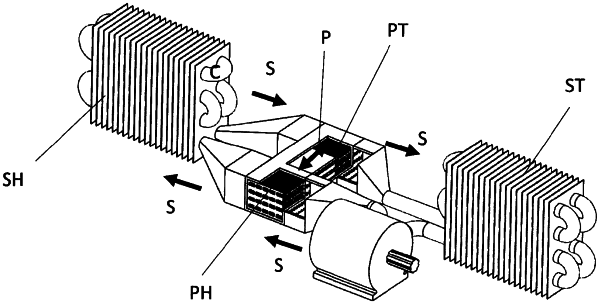| CPC F28F 13/003 (2013.01) [F02G 5/00 (2013.01); F25B 9/145 (2013.01); F25B 17/00 (2013.01); F25B 21/00 (2013.01); F28F 13/10 (2013.01); F28F 13/16 (2013.01); F02G 2257/00 (2013.01); F25B 2309/003 (2013.01); F25B 2309/1415 (2013.01); F25B 2321/001 (2013.01); F25B 2321/002 (2013.01)] | 17 Claims |

|
1. A method of heat transfer in an embedded structure of a heat regenerator, the method comprising:
operating a system that includes:
a plurality of segments formed from a porous regenerative material, where the segments are hydraulically separated, and where a temperature gradient through a particularly hydraulically separated segment is smaller than the temperature gradient established along the embedded structure of the heat regenerator;
a structure for flow of the primary fluid that oscillates through each of the hydraulically separated segments, consisting of porous regenerative material, with the oscillation in a direction that is approximately perpendicular to a direction of the temperature gradient, which is established along the embedded structure of the heat regenerator, whereas the primary fluid transfers or absorbs heat flux from a first and a second heat exchanger,
a first heat exchanger, which is hydraulically connected with a first side of hydraulically separated segments, the hydraulically separated segments formed from the porous regenerative material;
a second heat exchanger, which is hydraulically connected with a second side of the hydraulically separated segments, the hydraulically separated segments formed from the porous regenerative material;
a third heat exchanger that represents the connection with a heat source;
a fourth heat exchanger that represents the connection with a heat sink; and
a secondary fluid that flows through the third heat exchanger, the first heat exchanger, the fourth heat exchanger, and the second heat exchanger.
|